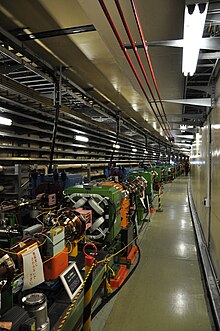KEKB


KEKB ( KEK - B -factory) was a particle accelerator complex operated from 1998 to 2010 at the Japanese research center KEK in Tsukuba , which was optimized for the production of B mesons . For this purpose, electrons and positrons were accelerated to energies of 8 and 3.5 GeV , respectively , with a linear accelerator, then combined in bunches of particles in two separate storage rings, each 3 kilometers in circumference , and targeted in the Belle detector - where the two rings intersect Brought a collision. Due to the different energies of the electrons and positrons at the collision point, it was an asymmetrical B-factory . The accelerator and detector were specially designed to observe the CP violation during the decay of B mesons.
history
At the end of the 1980s, plans were made to convert the existing KEK particle accelerator TRISTAN (1986–1995), which was approved by KEK in 1993, subject to the condition that the existing infrastructure and technology of TRISTAN be used to the maximum. Construction began in 1994 and in 1998 the KEKB and in 1999 the Belle detector were put into operation. The aim was to generate B mesons and to observe the CP violation as it decays. In contrast to the previous TRISTAN project, this required a 200 to 300-fold higher luminosity . KEKB was designed as a B-factory with asymmetrical energies, for which two separate storage rings for electrons (8 GeV) and positrons (3.5 GeV) were built in the existing 3 km long tunnel of TRISTAN. Furthermore, the former linear accelerator had to be upgraded and extended, as it was supposed to feed the particles into the storage rings with their maximum energy; the TRISTAN accumulation ring , which was then used as a pre-accelerator , was no longer required.
After more than ten years of successful operation, which also resulted in the 2008 Nobel Prize in Physics for Makoto Kobayashi and Toshihide Maskawa , the KEK-B factory was closed in June 2010. The SuperKEKB was built as the next accelerator at KEK , with the follow-up experiment Belle-II. The new storage rings were completed at the beginning of 2016 and after a successful test phase lasting several months, the Belle II detector was installed at the interaction point in the following year. After a further test phase in early 2018, multi-year scientific operations began in 2019.
Construction and operation
With the linear accelerator ( LINAC ) the electrons and positrons were accelerated to their maximum energies of 8 and 3.5 respectively and fed into the High Energy Ring (HER) with 8 GeV and into the Low Energy Ring (LER) with 3.5 GeV. The two separate storage rings have a circumference of 3016 m and intersect at the interaction point in the Belle detector (or later in the Belle II detector) in the Tsukuba experiment hall . In the Fuji experiment hall opposite , the rings change their horizontal position at different heights without the particles colliding with each other. The linear accelerator was built in the shape of a J for reasons of space and the electrons were deflected by 180 ° at an energy of 1.7 GeV. The positrons were generated by bombarding a 14 mm thick water-cooled tantalum plate with 3.7 GeV electrons in the lower part of the LINAC, and both types of particles were then accelerated to their final energies in the main part of the LINAC. The LINAC had a total length of around 600 meters and was thus 200 m longer than its predecessor (TRISTAN).
The desired luminosity of 10 34 cm −2 s −1 was achieved in 2003. Since the particle packets in the Belle detector cross at an angle of 22 mrad , the particle packets only partially penetrate each other at the point of interaction, which limits the achievable rate of particle collisions. By installing Crab Cavities 2007, which rotate the respective particle packets slightly before the collision, better penetration was achieved and by June 2009 the luminosity was increased to over 2 · 10 34 cm −2 s −1 ; this was the world record at the time (with TRISTAN only 5 · 10 31 cm −2 s −1 were achieved and in 2006 in the BaBar experiment of the PEP-II 1.2 · 10 34 cm −2 s −1 ).
literature
- Tetsuo Abe et al .: Achievements of KEKB. In: Progress of Theoretical and Experimental Physics (PTEP). 03A001, 2013, pp. 1–18, doi : 10.1093 / ptep / pts102 .
- Yoshitaka Kimura: FROM TRISTAN TO B – FACTORY. (PDF; 1.6 MB) In: IPAC'10 - Special Lectures to Commemorate the 120th Anniversary of Birth of Yoshio Nishina . Kyoto, Japan, May 23, 2010.
Web links
- KEKB website (English)
Individual evidence
- ↑ a b Yoshitaka Kimura: FROM TRISTAN TO B – FACTORY. (PDF; 1.6 MB) In: IPAC'10 - Special Lectures to Commemorate the 120th Anniversary of Birth of Yoshio Nishina. Kyoto, Japan, May 23, 2010.
- ↑ a b c d Tetsuo Abe et al .: Achievements of KEKB. In: Prog. Theor. Exp. Phys. 03A001, 2013, pp. 1–18, doi : 10.1093 / ptep / pts102 .
- ↑ Kazunori Akai, Kazuro Furukawa, Haruyo Koiso: SuperKEKB Collider. High Energy Accelerator Research Organization (KEK), September 10, 2018.
- ↑ Belle II - Beyond the Standard Model. Landscape of Research Infrastructures, Project Management DESY, accessed on March 3, 2019 .
- ^ I. Abe et al .: The KEKB injector linac. (PDF; 2.7 MB) In: Nuclear Instruments and Methods in Physics Research Section A. Vol. 499, No. 1, 2003, pp. 167-190, doi : 10.1016 / S0168-9002 (02) 01787-4 .
- ↑ S. Kurokawa, E. Kikutani: Overview of the KEKB accelerators. (PDF; 1.3 MB) In: Nuclear Instruments and Methods in Physics Research Section A. Vol. 499, No. 1, 2003, pp. 1-7, doi : 10.1016 / S0168-9002 (02) 01771-0 .
- ↑ PEP-II records. SLAC NATIONAL ACCELERATOR LABORATORY - PEP-II Currents and Luminosity, April 8, 2008, accessed August 29, 2013.
